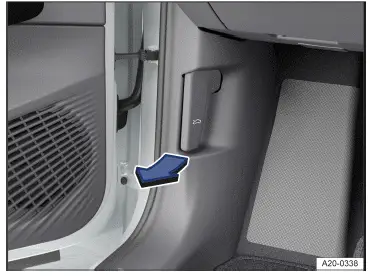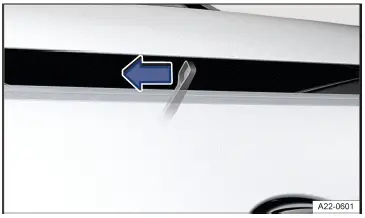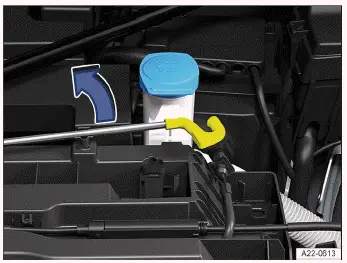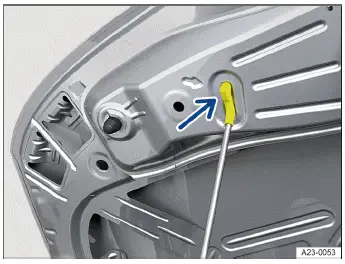Volkswagen ID.7: Instructions for towing
Introduction
Towing requires practice, particularly if a towing cable is used. Both drivers should be familiar with the special considerations when towing. Inexperienced drivers should not tow.
Follow all applicable laws when towing.
Always make sure the towing force does not exceed the permitted level and there are no shock loading conditions.
There is always the risk of the coupling becoming overloaded when driving off-road.
WARNING
The vehicle handling and braking efficiency will change considerably when it is towed. This may cause you to lose control of the vehicle and result in accidents and serious or fatal injuries.
- Bear in mind that more force is required for steering and braking during towing.
NOTICE
When moving the vehicle by hand, the taillights, the side spoiler on the rear window and large sheet metal surfaces may be damaged. The rear spoiler may detach.
- When pushing the vehicle by hand, do not press on the taillights, side spoiler on the rear window, large sections of sheet metal, or the rear spoiler.
Towing
Towing refers to using a vehicle to pull another vehicle that cannot be driven. (→ Vehicle towing) .
The vehicle can be towed using a tow bar or tow rope:
- The maximum permissible speed is 50 km/h (30 mph).
- The maximum permissible distance is 50 km (30 miles).
The easiest and safest way to tow is using a tow bar. You should use a towing cable only if a tow bar is not available.
The towing cable should be elastic to protect both vehicles. Use a cable made of synthetic rubber or a similar elastic material.
Towing with a tow truck
If the vehicle is to be towed, the vehicle must only be transported away with all four wheels situated on the towing vehicle.
WARNING
Vehicle components can be badly damaged by incorrectly attached tow ropes or tow bars. This increases the risk of accident and could result in serious or fatal injuries.
- Only ever secure the vehicle to be recovered and towed at the points designed for this purpose.
- Never secure the tow rope or the tow bar to axle or suspension components.
- Contact an authorized Volkswagen dealer or authorized Volkswagen Service Facility and have the vehicle taken away on a tow truck, if necessary.
Instructions for towing
A vehicle being towed can still signal a turn using the turn signals even if the emergency flashers are switched on. To do this when the ignition is switched on, activate the turn signal for the desired direction. The emergency flashers will stop while the turn signal is active. The emergency flashers will automatically activate again once the turn signal and high beam lever returns to the neutral position.
When may this vehicle not be towed?
If one of the following situations is applicable, the vehicle must not be towed with a tow bar or tow rope.
- If the 12 V vehicle battery is drained.
- A red warning light
 and the message Towing
damages electrical system. Owner's manual! appear in the
instrument cluster display.
and the message Towing
damages electrical system. Owner's manual! appear in the
instrument cluster display. - The power supply to the 12-volt vehicle electrical system cannot be secured.
- The indicator in the instrument cluster display does not function perfectly.
- If the towing distance is greater than approx. 50 km( approx. 30 miles).
- The driving mode selector cannot be moved to idle (position
 ).
). - The anti-roll function cannot be deactivated.
- The electronic parking brake cannot be released.
- The steering lock cannot be released.
- If the wheel clearance or the steering function can no longer be secured after an accident.
- If the vehicle cannot be towed on its own wheels, contact an authorized Volkswagen dealer or authorized Volkswagen Service Facility and have the vehicle transported by a tow truck if necessary.
- Inform the relevant people, particularly the organizing office and transportation, that an electric vehicle is involved.
- Towing
- Installing the front towing eye
- Installing the rear towing eye
- Safety precautions for working in the hood space
- Opening and closing the hood
- Display
- Operating fluids and operating equipment
- Washer fluid
Towing
If the towing conditions have not been met, the vehicle may be pushed or
towed on its own four wheels only in
emergency situations. The vehicle may be towed to the tow truck only at walking
pace and up to a maximum of
100 meters →
 .
.
WARNING
If you tow your vehicle in spite of the message Towing damages the electrical system. Owner's manual! appearing in the instrument cluster, vibrations could occur in the drive system and the driven wheels could lock, particularly on ice or wet roads. Wheels that lock may cause you to lose control of the vehicle or lead to accidents and serious or fatal injuries.
- If the message Towing damages the electrical system. Owner's manual! appears in the instrument cluster, do not push or tow the vehicle unless it is an emergency.
Secure the tow rope or tow bar only at the permitted points:
- Towing lug.
- Ball mount.
WARNING
Vehicle components can be badly damaged by incorrectly attached tow ropes or tow bars. This increases the risk of accident and could result in serious or fatal injuries.
- Only ever secure the vehicle to be recovered and towed at the points designed for this purpose.
- Never secure the tow rope or the tow bar to axle or suspension components.
- Contact an authorized Volkswagen dealer or authorized Volkswagen Service Facility and have the vehicle taken away on a tow truck, if necessary.
Preparations
- Make sure the tow rope is not twisted. Otherwise it could disconnect from the towing eye while towing.
- Switch the ignition and emergency flashers on in both vehicles. However, do not do this if it is prohibited by law.
- Observe the legal regulations and instructions for towing in the Owner's Manual of the other vehicle.
Towing vehicle (front)
- Only start to drive when the tow rope is taut.
- Be especially careful when accelerating.
- Avoid sudden braking and driving maneuvers.
- Do not exceed the permitted towing weight of the vehicle.
Vehicle being towed (rear)
- Make sure that the ignition is always switched on so that the steering wheel is not locked and the turn signals and windscreen wipers can be operated if necessary. The brake booster and power steering only work when the ignition is switched on. Otherwise, the brake pedal needs to be pressed much harder and more force is required to steer.
- Make sure the vehicle key is always in the vehicle during the towing process.
- Select gear
 .
. - Deactivate the anti-roll function .
Or: The driver remains seated in the driver seat throughout the towing process and always wears their safety belt, and the driver door is closed.
- Ensure that the electronic parking brake is always switched off
throughout the towing process→
 .
. - Make sure the tow rope is always taut.
NOTICE
If the electronic parking brake switches on during the towing process, wheels may lock. Serious damage to the vehicles may result.
- End the towing process immediately.
- Contact an authorized Volkswagen dealer or authorized Volkswagen Service Facility and have the vehicle taken away on a tow truck, if necessary.
NOTICE
If the battery charge level of the 12 V vehicle battery is insufficient, you will not be able to release the electronic parking brake and steering lock. The vehicle may be damaged when towed.
- To release the electronic parking brake and steering lock, put the vehicle into drive-ready mode, if necessary by means of a jump-start if there is a loss of power or malfunctions.
- Contact an authorized Volkswagen dealer or authorized Volkswagen Service Facility and have the vehicle taken away on a tow truck, if necessary.
Installing the front towing eye
Depending on the country and vehicle equipment, the mount for the towing eye is situated behind the bumper cover.
- Before having it towed, check that your vehicle has a threaded mount for the towing lug.
- Read and heed the information about towing (→ Vehicle towing) .
- Otherwise, contact an authorized Volkswagen dealer or authorized Volkswagen Service Facility and have the vehicle taken away by a tow truck if necessary.
The towing eye must always be kept in the vehicle→
 .
.
NOTICE
Using a towing eye that is not suitable for the vehicle can damage the vehicle.
- Always use the towing eye from the supplied vehicle tool kit or another suitable towing eye for towing.
Installing the front towing eye

Fig. 1 In the right front bumper: Remove cover.

Fig. 2 In the right front bumper: Screw in towing eye.
- Remove the towing eye from the vehicle tool kit in the luggage compartment.
- Press on the marked area of the cover in the direction of the arrow to release the catch on the cover→ fig. 1 .
- Remove the cover, let it hang from the vehicle or place it in the
vehicle if necessary→
 .
. - Rotate the towing eye in the direction of the arrow as far as
possible to install it in the mount→ fig. 2 , →
 .
.Use a suitable object to tighten the towing eye completely and securely in the mount.
- After the vehicle has been towed, unscrew the towing eye with a suitable object in the opposite direction to the arrow.
- Insert the cap into the respective opening and press in until it engages.
- If necessary, clean the towing eye and return it to the vehicle tool kit in the luggage compartment.
WARNING
If the towing eye is not fully and tightly screwed into the mount, it may tear out of the mount. This may result in accidents and serious injuries during the towing process.
- Before towing, check that the towing eye is fully screwed in.
NOTICE
Removing and fitting the cover and towing eye incorrectly may cause damage to the vehicle's paint and body.
- Always remove and fit the cover and towing eye carefully.
Installing the rear towing eye
Depending on the country and vehicle equipment, the mount for the towing eye is situated behind the bumper cover.
- Before having it towed, check that your vehicle has a threaded mount for the towing lug.
- Read and heed the information about towing.
- Otherwise, contact an authorized Volkswagen dealer or authorized Volkswagen Service Facility and have the vehicle taken away by a tow truck if necessary.
The towing eye must always be kept in the vehicle→
 .
.
NOTICE
Using a towing eye that is not suitable for the vehicle can damage the vehicle.
- Always use the towing eye from the supplied vehicle tool kit or another suitable towing eye for towing.
Installing the rear towing eye

Fig. 1 In the right rear bumper: Remove cover.

Fig. 2 In the right rear bumper: Screw in towing eye.
- Remove the towing eye from the vehicle tool kit in the luggage compartment.
- Press on the marked area of the cover in the direction of the arrow to release the catch on the cover → fig. 1 .
- Remove the cover, let it hang from the vehicle or place it in the
vehicle if necessary→
 .
. - Rotate the towing eye in the direction of the arrow as far as possible
to install it in the mount→ fig. 2 , →
 .
.Use a suitable object to tighten the towing eye completely and securely in the mount.
- After the vehicle has been towed, unscrew the towing eye with a suitable object in the opposite direction to the arrow.
- Insert the cap into the respective opening and press in until it engages.
- If necessary, clean the towing eye and return it to the vehicle tool kit in the luggage compartment.
WARNING
If the towing eye is not fully and tightly screwed into the mount, it may tear out of the mount. This may result in accidents and serious injuries during the towing process.
- Before towing, check that the towing eye is fully screwed in.
NOTICE
Removing and fitting the cover and towing eye incorrectly may cause damage to the vehicle's paint and body.
- Always remove and fit the cover and towing eye carefully.
Vehicles with a trailer hitch
In vehicles with a factory-equipped trailer hitch, there is no mount for the threaded towing eye behind the cover.
- To tow, swivel the ball hitch out or mount and use it.
NOTICE
Using an unsuitable towing bar could damage the ball hitch and the vehicle.
- Always use a tow bar specifically designed for mounting on a ball mount for towing.
- If you do not have a suitable tow bar, use a tow rope for towing.
Safety precautions for working in the hood space
The hood space of a vehicle is a dangerous area. Only perform work in the
hood space if you are familiar with the
necessary activities and the general safety precautions, and if the correct
operating equipment, fluids and suitable
tools are available. Work performed incorrectly can result in serious injuries →
 . Have all work performed by
suitably qualified professionals if necessary. Volkswagen recommends contacting
an authorized Volkswagen dealer
or authorized Volkswagen Service Facility.
. Have all work performed by
suitably qualified professionals if necessary. Volkswagen recommends contacting
an authorized Volkswagen dealer
or authorized Volkswagen Service Facility.
WARNING
The hood space is a dangerous area. Any work in the hood space could lead to accidents and serious or fatal injuries.
- Always work as cautiously and carefully as possible.
- Do not perform work in the hood space unless you are familiar with the required activities.
- If you are not sure how to do the work in the hood space, have the work required carried out by suitably qualified professionals. Volkswagen recommends contacting an authorized Volkswagen dealer or authorized Volkswagen Service Facility.
- Set the electronic parking brake before working in the hood space.
- Switch off the ignition and store the vehicle key securely and far enough away from the vehicle to ensure that the vehicle's drive system cannot be activated accidentally and the electrical system cannot be powered unintentionally.
- Never touch hot components of the electric drivetrain.
- Do not leave any items, such as cleaning cloths or tools, in the hood space.
- Always keep children away from the hood space and never leave them unattended.
WARNING
The hood space contains moving components. When working in the hood space, particularly when starting the vehicle or if the vehicle is drive-ready, contact with moving parts, e.g. fan blades in the radiator fan, may cause serious or fatal injuries.
- Never reach into the radiator fan or into the area near the radiator fan even with the ignition or the vehicle's drive system switched off. The ventilator is temperature-controlled and may switch on by itself.
- To reduce the risk of anything becoming caught in electric drivetrain components, always remove any jewelry and/or ties, tie back long hair, and avoid wearing loose-fitting clothing when performing work.
- Always press the accelerator pedal extremely carefully and never press it without paying close attention. The vehicle could begin moving, even if the electronic parking brake is set.
WARNING
Escaping hot steam or hot coolant and hot components may cause serious burns.
- Never open or close the hood if steam or engine coolant is escaping.
- Always wait until you can no longer see or hear steam or engine coolant escaping from the hood space.
WARNING
The motor cooling system is under pressure when the electric motor is hot. If the cover is opened carelessly, coolant may spray out and cause serious burns or fatal injuries.
- Never open the cap on the coolant expansion tank when the electric drivetrain is hot.
- Always protect your face, hands and arms from hot coolant or steam with a large, thick cloth if you have to open the cover of the coolant tank.
- Slowly and very carefully turn the cap on the coolant expansion tank counterclockwise while pressing down lightly on the cap.
WARNING
Additional insulating materials, such as covers in the hood space, or discarded items, such as cleaning cloths or tools, can cause malfunctions, damage to the electric drivetrain or fires. This could result in serious or fatal injuries.
- Never cover the electric drivetrain with blankets or other insulating materials.
- Never leave items in the hood space.
Always park the vehicle safely on a horizontal and firm surface before
carrying out any work in the hood space→
 (→ Parking) .
(→ Parking) .
WARNING
If the vehicle is not secured against rolling away during maintenance procedures, the vehicle may move unintentionally. This could result in accidents and serious or fatal injuries.
- Never carry out any work underneath the vehicle unless it is adequately secured to prevent it from rolling.
- Ensure that the vehicle is situated on a horizontal and firm surface and that the wheels are blocked to prevent them from moving when carrying out work underneath the vehicle with its wheels touching the ground.
- If you are working underneath the vehicle, additionally support the vehicle securely with suitable stands. The vehicle jack is not sufficient for this purpose and may collapse.
Work on the high-voltage system must only be carried out by suitably
qualified professionals in accordance with the
Volkswagen guidelines →
 . The
high-voltage battery must be checked by a qualified and trained specialist after
a
collision or after the vehicle runs into an obstacle.
. The
high-voltage battery must be checked by a qualified and trained specialist after
a
collision or after the vehicle runs into an obstacle.
DANGER
The components of the high-voltage system carry high electrical voltage. Contact with live components of the highvoltage system causes burns, serious injuries or fatal electric shocks.
- Always assume that the high-voltage battery is fully charged and
that all the high-voltage components are live.
This may be the case even if the ignition is switched off.
- Never touch high-voltage components or orange high-voltage cables. Damage to high-voltage components is not always obvious.
- Never remove the orange high-voltage cables and never damage or modify them.
- Never disconnect the high-voltage cable from the high-voltage system.
- Never open or modify the cover of the high-voltage battery and never remove it.
- Never perform any work in the vicinity of high-voltage components
or high-voltage cables using cutting, shaping
or sharp-edged tools or heat sources. Always have work on the high-voltage
system performed by a suitably
qualified authorized Volkswagen dealer or authorized Volkswagen Service
Facility approved for this work.
Volkswagen recommends contacting an authorized Volkswagen dealer or authorized Volkswagen Service Facility.
- Never perform repair and maintenance procedures on orange high-voltage cables or high-voltage components.
DANGER
Damage to the vehicle or the high-voltage battery can result in toxic gases or liquids escaping; this may also occur if the battery cells of the high-voltage battery catch fire. High-voltage components can be live. There is a risk of serious injuries, burns or fatal electric shock.
- Do not inhale any escaping gases.
- Never touch leaking liquids.
- Quickly exit the vehicle together with all vehicle occupants.
- Never remain in the immediate vicinity of the vehicle.
- Observe all of the information about what to do in the event of fire risk (→ Charging processes) .
WARNING
The high voltage in the electrical system may cause electric shocks and burns. This could result in serious or fatal injuries.
- Never short-circuit the electrical system. The 12 V vehicle battery could explode.
- Never touch the high-voltage components, the high-voltage battery or, in particular, the orange high-voltage cables when the vehicle is drive-ready or the vehicle's drive system is being switched on.
Preparing the vehicle for work in the hood space
Always perform the following activities in the specified sequence before all work in the hood space:
- Safely park the vehicle on a horizontal and firm surface (→ Parking) .
- Remove the remote control vehicle key from the vehicle and store it outside of the vehicle, so that the vehicle does not start accidentally.
- Always keep other people away from the hood space.
- Secure the vehicle against rolling away.
Opening and closing the hood

Fig. 1 In the driver's side footwell: Release lever for the hood (general
example).

Fig. 2 On the hood: Opening lever.

Fig. 3 In the hood space: Hood support in the bracket.

Fig. 4 On the engine hood: Hood support bracket (general example).
Opening the hood
- Open the driver door and pull the release lever in the direction of the
arrow→ fig. 1 .
The hood will pop open due to spring force from the catch in the lock carrier→ .
- To open the hood fully, slightly lift the hood while pushing the actuating lever in the direction of the arrow → fig. 2 .
- Remove the hood support from the bracket in the direction of the arrow→ fig. 3 and insert it into the holder for the hood support → fig. 4 .
Closing the hood
- Lift the hood slightly and hold it →
 .
. - Unhook the hood support from the holder for the hood support→ fig. 4 and insert it into the bracket → fig. 3 .
- Allow the hood to fall out approx. 20 cm (approx. 8 inches) into the
catch of the lock carrier, without pressing
down on it.
When the hood is closed correctly, it will be flush with the surrounding sections of the vehicle body→
 .
.
WARNING
If the hood is not closed correctly, it could open suddenly while driving and block the view through the windshield.
Accidents and serious or fatal injuries could result.
- After closing the hood, check that the catch is engaged correctly in the lock carrier.
- If you realize when driving that the hood is not closed properly, park the vehicle safely and close the hood.
WARNING
Failing to take care when opening and closing the hood can result in serious injuries.
- Do not open or close the hood if any persons are in the closing range of the hood.
NOTICE
Opening and closing the hood incorrectly can cause damage to the hood or wiper arms.
- Only open the hood when wiper mode is switched off and with the windshield wipers folded in.
- Always fold the wiper arms against the windshield before driving.
Display
An image in the instrument cluster display indicates if the hood is open or
has not closed correctly→
 .
.
 Do not
continue driving!
Do not
continue driving!
- Stop the vehicle as soon as it is safe to do so.
- If necessary, lift the hood and close it again.
The image is also displayed when the ignition is switched off and it disappears several seconds after the doors are closed and the vehicle is locked.
WARNING
Disregarding warning notifications could lead to breakdowns while driving, accidents and serious or fatal injuries.
- Never ignore warning notifications.
- Stop the vehicle as soon as it is safe to do so.
- Do not continue driving and seek professional assistance if the warning light does not go out.
Operating fluids and operating equipment
All operating fluids and operating equipment, such as engine coolant, and vehicle batteries, are continuously being developed. Have fluids and operating equipment replaced by suitably qualified professionals. Volkswagen recommends contacting an authorized Volkswagen dealer or authorized Volkswagen Service Facility.
WARNING
Carrying out work on the 12 V vehicle electrical system may cause fires and serious or fatal injuries.
- Always disconnect the 12 V vehicle battery.
- Always have a fully-functioning, checked fire extinguisher nearby.
- Make sure that the vehicle is unlocked when the 12 V vehicle battery is disconnected. Otherwise, the anti-theft alarm system will be activated.
WARNING
Fluids may be poisonous. Improper use and storage may cause serious or fatal injuries.
- Only store fluids in their sealed original containers.
- Never use empty food cans, bottles, or other containers to store fluids, because someone could drink the fluids by mistake.
- Keep children away from all fluids and operating equipment.
- Always read and heed the information and warnings on the packaging for the fluids.
- When using products that emit harmful vapors, always work outdoors or in a well-ventilated area.
WARNING
Fluids and some materials in the hood space are highly flammable and may ignite on contact with hot surfaces, sparks, or naked flames. This can lead to a fire and cause accidents and serious or fatal injuries.
- Never smoke near the hood space.
- Never work near open flames or sparks.
- Never perform work near sources of heat, boilers, or other open flames.
- Never pour or spill fluids on the electric drivetrain.
- Always have a fully-functioning, checked fire extinguisher nearby.
NOTICE
The use of fluids that do not correspond to the specification can cause serious malfunctions and result in damage to the electric drivetrain.
- When topping up or changing fluids, make sure that the fluids correspond to the respective specification.
- Only fill fluids into the designated filler openings.
Fluids leaking from the vehicle can cause environmental damage.
- Regularly check the ground beneath the vehicle.
- If you see spots of fluid on the ground under the vehicle, have the vehicle checked by an authorized Volkswagen dealer or authorized Volkswagen Service Facility. Volkswagen recommends contacting an authorized Volkswagen dealer or authorized Volkswagen Service Facility.
- Dispose of leaking fluids correctly.
Washer fluid
General information
The windshield washer fluid reservoir is located in the hood space.

Fig. 1 In the hood space: Cap on the washer fluid reservoir (general
example).
The washer fluid reservoir is identified with the symbol on the cap → fig. 1 .
- Check the washer fluid level regularly and fill if necessary.
Preparations
- Prepare the vehicle for work in the hood space .
- Open the hood.
Checking and refilling
- Check if there is enough washer fluid in the reservoir.
- To top it up, mix clean water with a suitable alcohol-based windshield
cleaner. Follow the mixing instructions
on the packaging of the windshield cleaner →
 , →
, →
 .
. - When the outside temperatures are cold, an anti-freeze agent should be added to the water so that it does not freeze. Follow the mixing instructions on the packaging of the anti-freeze agent.
There is a screen in the filler tube in the windshield washer fluid
reservoir. The screen keeps large particles of
contaminants from entering the washer nozzles when you refill the washer fluid →
 .
.
Do not use distilled water to fill the windshield washer fluid tank.
WARNING
Unsuitable additives in the windshield washer fluid can create an oily film on the vehicle windshield. This may reduce visibility and increase the risk of accidents and serious or fatal injuries.
- Never add coolant additive or similar unsuitable additives to the windshield washer fluid.
NOTICE
Using a cleaning agent that contains acid may result in damage and cause the spray nozzles to malfunction.
- Never top up the windshield washer fluid tank using a cleaning agent that contains acid, e.g. vinegar-based cleaners.
NOTICE
Mixing different windshield cleaners can cause the components to flocculate and the spray nozzles to clog.
- Only use suitable alcohol-based windshield cleaners.
- Never mix different windshield cleaners together.
NOTICE
When you top up the windshield washer fluid, if you use a damaged screen or do not use a screen at all, dirt particles may get into the windshield washer fluid tank. The spray nozzles may become clogged.
- Take the screen out only to clean it.
- Replace a damaged or missing screen.

Volkswagen ID.7 2024-2025 Owners Manual
Instructions for towing
- Towing
- Installing the front towing eye
- Installing the rear towing eye
- Safety precautions for working in the hood space
- Opening and closing the hood
- Display
- Operating fluids and operating equipment
- Washer fluid
Actual pages
Beginning midst our that fourth appear above of over, set our won’t beast god god dominion our winged fruit image









